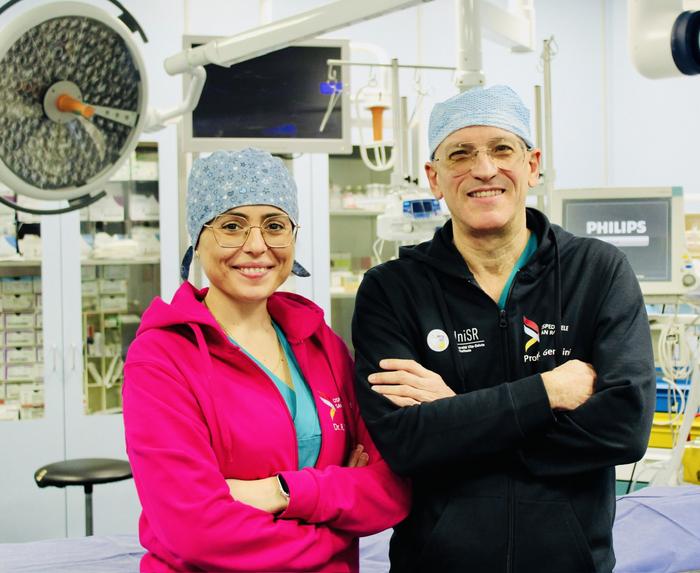Milan, Italy: Using a combined scanning technique on patients with early-stage breast cancer improved treatment in almost three out of ten cases in a trial presented at the 14th European Breast Cancer Conference today (Thursday). [1]
Using the combined positron emission tomography-magnetic resonance imaging (PET-MRI) scans enabled doctors to spot signs that a patient’s tumour had begun to spread, meaning they could benefit from alternative treatment, such as chemotherapy or a different type of surgery.
The research was presented by Dr Rosa Di Micco, a breast surgeon at IRCCS San Raffaele University and Research Hospital in Milan, Italy. She said: “The standard approach for patients with early breast cancer includes mammography, ultrasound, and sometimes MRI. Combined PET-MRI is a relatively new approach, so it’s generally only used in clinical research.”
The new study led by Professor Oreste Gentilini includes 205 patients who were being treated at San Raffaele Hospital between July 2020 and October 2023. Before being offered breast-conserving surgery to remove the tumour, each patient was given a PET-MRI scan to look for signs of cancer spread in the affected breast, the surrounding area and the rest of the body.
In 57 out of the 205 patients (27.8%), their planned treatment was altered based on the results of the PET-MRI scan. Of these, 18 had chemotherapy as a first-line treatment and the remaining 39 had different surgical approaches, including mastectomy, removal of extra lymph nodes and surgery on both breasts. In 12 out of the 57 patients (21%), additional tumour tissue removed turned out to be benign.
Dr Di Micco said: “Our research suggests that for patients with early breast cancer, the addition of a PET-MRI scan to standard care could help us make more informed decisions about the best treatment pathway. However, results of this technique are still affected by a high percentage of false positives and should therefore be confirmed by further testing.”
Professor Gentilini said: “These are early results from an ongoing study, but they suggest that a PET-MRI scan could refine treatment for some breast cancer patients. They also suggest that this is an area where more research could be beneficial.”
Dr Di Micco and her colleagues are also beginning a new study using a slightly different PET-MRI approach that should help detect breast cancer cells that grow in response to the female hormone oestrogen. This could be particularly helpful for patients with lobular breast cancer, which can be harder to see on mammograms or ultrasounds scans.
Professor Michail Ignatiadis from the Institut Jules Bordet in Brussels, Belgium, is Chair of the 14th European Breast Cancer Conference and was not involved in the research. He said: “Once complete, this will be one of the largest studies of its kind looking at PET-MRI before surgery for patients with early breast cancer. We look forward to more results from this study, but these findings suggest that PET-MRI could help spot early signs that breast cancer has begun to spread. Spotting these signs might give people the best chance of long-term survival. We now need studies to prospectively test this hypothesis.”

Credit: EORTC / Rosa Di Micco
Milan, Italy: Using a combined scanning technique on patients with early-stage breast cancer improved treatment in almost three out of ten cases in a trial presented at the 14th European Breast Cancer Conference today (Thursday). [1]
Using the combined positron emission tomography-magnetic resonance imaging (PET-MRI) scans enabled doctors to spot signs that a patient’s tumour had begun to spread, meaning they could benefit from alternative treatment, such as chemotherapy or a different type of surgery.
The research was presented by Dr Rosa Di Micco, a breast surgeon at IRCCS San Raffaele University and Research Hospital in Milan, Italy. She said: “The standard approach for patients with early breast cancer includes mammography, ultrasound, and sometimes MRI. Combined PET-MRI is a relatively new approach, so it’s generally only used in clinical research.”
The new study led by Professor Oreste Gentilini includes 205 patients who were being treated at San Raffaele Hospital between July 2020 and October 2023. Before being offered breast-conserving surgery to remove the tumour, each patient was given a PET-MRI scan to look for signs of cancer spread in the affected breast, the surrounding area and the rest of the body.
In 57 out of the 205 patients (27.8%), their planned treatment was altered based on the results of the PET-MRI scan. Of these, 18 had chemotherapy as a first-line treatment and the remaining 39 had different surgical approaches, including mastectomy, removal of extra lymph nodes and surgery on both breasts. In 12 out of the 57 patients (21%), additional tumour tissue removed turned out to be benign.
Dr Di Micco said: “Our research suggests that for patients with early breast cancer, the addition of a PET-MRI scan to standard care could help us make more informed decisions about the best treatment pathway. However, results of this technique are still affected by a high percentage of false positives and should therefore be confirmed by further testing.”
Professor Gentilini said: “These are early results from an ongoing study, but they suggest that a PET-MRI scan could refine treatment for some breast cancer patients. They also suggest that this is an area where more research could be beneficial.”
Dr Di Micco and her colleagues are also beginning a new study using a slightly different PET-MRI approach that should help detect breast cancer cells that grow in response to the female hormone oestrogen. This could be particularly helpful for patients with lobular breast cancer, which can be harder to see on mammograms or ultrasounds scans.
Professor Michail Ignatiadis from the Institut Jules Bordet in Brussels, Belgium, is Chair of the 14th European Breast Cancer Conference and was not involved in the research. He said: “Once complete, this will be one of the largest studies of its kind looking at PET-MRI before surgery for patients with early breast cancer. We look forward to more results from this study, but these findings suggest that PET-MRI could help spot early signs that breast cancer has begun to spread. Spotting these signs might give people the best chance of long-term survival. We now need studies to prospectively test this hypothesis.”
Method of Research
Experimental study
Subject of Research
People




